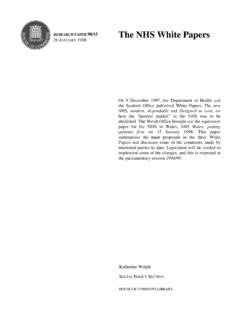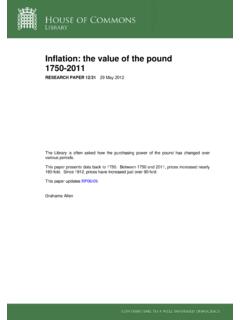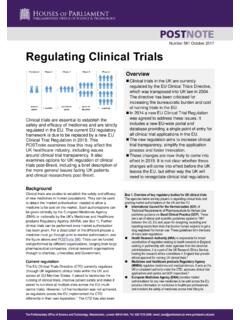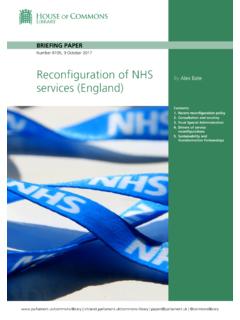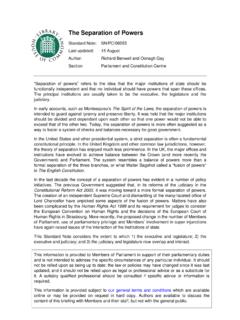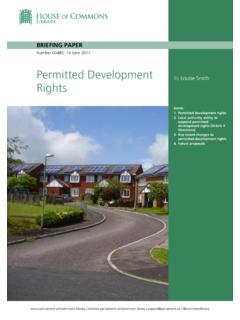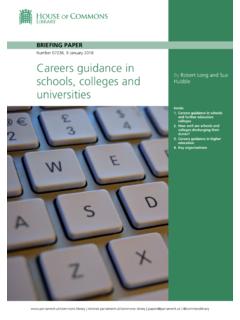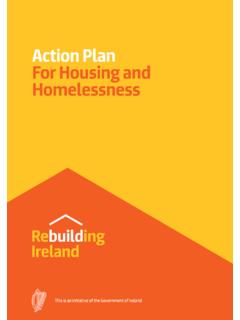Transcription of Rent setting: social housing (England)
1 | | | @commonslibrary BRIEFING PAPER Number 01090, 13 November 2017 rent setting : social housing ( england ) By Wendy Wilson Inside: 1. Rent restructuring and convergence under Labour 2. The Coalition Government s rent policy 3. Summer Budget 2015: reducing rents by 1% 4. Affordable rents 5. Pay to stay at market rents 6. rent setting policy 2020-25 7. Alternative rent models Number 01090, 13 November 2017 2 Contents Summary 3 1. Rent restructuring and convergence under Labour 5 rent setting 2008-09 and 2009-10 7 rent setting 2010-11 10 2. The Coalition Government s rent policy 15 Self-financing for local authority HRAs April 2012 15 rent setting 2012-13 17 rent setting 2013-14 17 A ten year rent settlement from 2015 18 The end of convergence 19 Guidance on social housing rents from April 2015 24 Comment 25 3.
2 Summer Budget 2015: reducing rents by 1% 26 Comment 28 4. Affordable rents 33 5. Pay to stay at market rents 35 6. rent setting policy 2020-25 37 7. Alternative rent models 38 A living rent? 38 Rent flexibility for housing associations? 38 Cover page image copyright: Wendy Wilson 3 rent setting : social housing ( england ) Summary In 2002 the Labour Government introduced a rent convergence policy under which, over a ten year period, rents in social housing (local authority and housing association owned stock) were to be brought into alignment. A rent formula was established with actual rents moving towards a national formula rent which took account of values of properties and local earnings relative to national earnings. A bedroom weighting factor was also applied to try and ensure the resulting rents better reflected the perceived value of the properties.
3 These formula rents were increased each year by the Retail Prices Index (RPI) + The Coalition Government continued this rent setting process with (initially) a revised target convergence date for local authorities of 2015-16, subject to a maximum annual rent rise for an individual tenant of RPI + + 2 per week. As part of the 2013 Spending Round the Coalition Government announced that from 2015-16 social rents will rise by CPI plus 1% each year for 10 years. Following this announcement, DCLG sent a letter to housing bodies on 2 July 2013 in which plans to cut short the policy of converging council and housing association rents were revealed. social landlords whose average rents had not yet reached target levels were concerned about the implications for their ability to repay debt and invest in new and existing social housing stock, but the certainty delivered by a 10-year rent settlement was welcomed.
4 The Draft Guidance on Rents for social housing from 2015 to 2016 consultation was published in October 2013 with a summary of responses published in May 2014. At the same time, the Government published its policy on rents for local authority owned social housing from April 2015 onwards - Guidance on rents for social housing . The guidance confirmed the intention to proceed with its policy of ending rent convergence in April 2015, and that CPI plus 1% would form the basis of rent increases for the next ten years. The certainty of the 10 year settlement was short-lived; on 8 July 2015 (Summer Budget 2015) the Chancellor announced that rents in social housing would be reduced by 1% a year for four years resulting in a 12% reduction in average rents by 2020-21. The measure was forecast to save billion by 2020-21, primarily in reduced housing Benefit expenditure.
5 Around million tenants not in receipt of housing Benefit in the social rented sector were expected to benefit by 700 per year (current prices). This policy change was unexpected and was greeted with some dismay by social landlords who had to model the impact on their business plans. Providers of supported housing , where rent levels tend to be higher, expressed particular concerns about the viability of these schemes. The Government responded to these concerns at the end of January 2016 with the announcement of a year-long exception for all supported housing from the 1% rent reduction. On 15 September 2016 the Secretary of State announced that the deferral of the 1% rent reductions would end. Rent reductions are now being applied to supported housing schemes so that rents for these properties will decrease by 1% a year for 3 years up to and including 2019-20.
6 An exemption for specialised supported housing remains in place over the period and has been extended to include fully mutuals/co-operatives, alms houses, Community Land Trusts and refuges. The Office for Budget Responsibility (OBR) predicted an overall reduction in housing investment as a result of the rent reduction policy. The measure has been implemented through provisions contained in the Welfare Reform and Work Act 2016. Number 01090, 13 November 2017 4 The National housing Federation is lobbying for flexibility for associations to set their own rents. The housing White Paper, Fixing our broken housing market (February 2017), included a commitment to develop a rent policy for social landlords beyond 2020. On 4 October 2017, DCLG announced that increases to social housing rents will be limited to the Consumer Price Index (CPI) plus 1% for 5 years from 2020.
7 housing policy is a devolved matter; different rent setting policies apply in Scotland, Wales and Northern Ireland. Changes to housing Benefit are not devolved, aside from certain limited circumstances in Scotland. This means that changes to housing Benefit entitlement have an impact on the rental income of social landlords in the devolved nations. 5 rent setting : social housing ( england ) 1. Rent restructuring and convergence under Labour Background and rationale The different rent levels charged by councils and private registered providers of social housing1 have, historically, reflected when and where the housing had been built over many decades; changes in the capital and revenue subsidies given to social landlords; and the different rent policies pursued. The Labour Governments of 1997-2010 wanted to see an end to arbitrary differences between the rents of similar properties in a locality and between those for similar properties in neighbouring areas: For example, in a report published in 2000, the Chartered Institute of housing cited two adjoining London boroughs where one charged 15 more each week than its neighbouring borough for properties of a very similar standard.
8 And in a large southern city there was a 24 gap in the rent charged each week by the local authority and a local registered social landlord for otherwise similar three bedroom homes. Tenants see that it is unfair when there is no apparent explanation for the pattern of rents in a locality, whether in terms of relative property quality, relative attractiveness of location or relative running The then Minister for housing , Sally Keeble, outlined the rationale behind rent restructuring in an adjournment debate in December 2001: Our policy on rent restructuring is part of the Government's wider housing agenda. The aim is to close the gap between rents in different sorts of social housing and, as my hon. Friend said, to pave the way for greater choice for social housing tenants. That applies not just to different council properties in the same area but to different sorts of social housing tenure, because at present the perception that housing association rents are high can be a bar to people who might consider applying for that sort of housing .
9 We want a sensible structure of rents so that tenants can choose whether to pay more for a better property or to save money by choosing a less popular property. To achieve that, we are establishing a common basis for social rents throughout england by linking rents to both the value and size of the property and to manual earnings in the area. The new rents must be affordable and we are linking them to local earnings to ensure that. They will not be market rents. Rents in the social sector throughout most of the country will generally remain well below what a tenant would pay for the property from a private landlord. I said that that will apply throughout most of the country, because some areas have very low demand and different trends in property The Labour Government s policy was that all social landlords (local authorities and housing associations) should offer similar rents for 1 Also referred to as housing associations and registered social landlords (RSLs).
10 2 housing Green Paper, Quality and Choice: A decent home for all, April 2000, para 3 HC Deb 5 December 2001 c135WH Number 01090, 13 November 2017 6 similar properties, whilst maintaining substantial discounts to market rents. Preparing for restructuring involved calculating the 'formula rent' which was the target rent figure for each individual council and housing association home for ten years time ( by 2011/12 initially). The formula rent was based on a combination of individual property values and average earnings in each Each year the Department (now Communities and Local Government, DCLG) suggested a guideline rent level to which councils should move their rents in order to help them eventually reach their formula rents at the end of the ten year period in 2011 DCLG included information for local authorities on proposed national guideline rents in the draft housing Revenue Account determination which was issued at the end of each calendar year (prior to the implementation of self-financing in April 2012).


